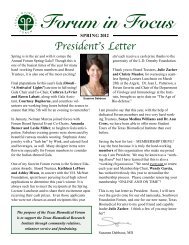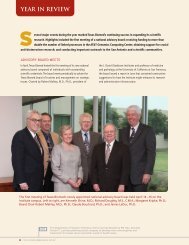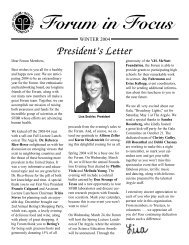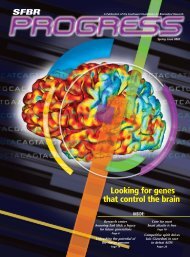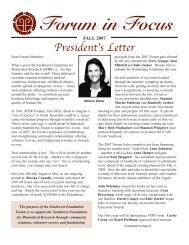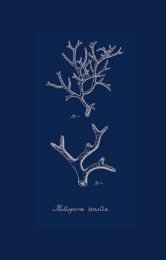Texas Biomed Science Report 2011-2012 - Texas Biomedical ...
Texas Biomed Science Report 2011-2012 - Texas Biomedical ...
Texas Biomed Science Report 2011-2012 - Texas Biomedical ...
Create successful ePaper yourself
Turn your PDF publications into a flip-book with our unique Google optimized e-Paper software.
Andrew Hayhurst, Ph.D.<br />
Associate Scientist, Virology and Immunology<br />
The spectrum of operating conditions under which field portable<br />
diagnostics and detection systems are used in the field is enormous.<br />
The harshest conditions are usually found in resource-poor areas of<br />
the world where electricity and refrigeration are rare, and re-supply is<br />
difficult. Such areas require extremely rugged yet simple-to-operate<br />
single-use (dipstick) systems with long shelf-lives. Harsh conditions<br />
also exist on the homeland front due to the need for constant<br />
real-time environmental monitoring of biothreats in multiplex. A<br />
highly promising antibody format with the potential to solve these<br />
problems is the single-domain antibody (sdAb or nanobody).<br />
Hayhurst’s team has generated sdAb specific for Marburgvirus<br />
and Ebolaviruses which are highly lethal African hemorrhagic fever<br />
viruses sporadically yet explosively emerging and also are Centers for<br />
Disease Control “bioterror” threats. The sdAb appear to approach the<br />
sensitivity of current detection systems, yet are refoldable and therefore<br />
more stable. Hayhurst’s team is currently using in vitro evolution<br />
within a novel selection and screening system he recently invented to<br />
further improve the limits of detection of these antibodies to enable<br />
a practical dipstick assay to be developed for these infections.<br />
Another group of biothreats of interest to Hayhurst are the botulinum<br />
neurotoxins, which are the most poisonous substances currently known<br />
— estimated to be 100 billion times more toxic than cyanide. The<br />
Left to right: Laura Sherwood,<br />
Divya Nandamudi, Andrew<br />
Hayhurst, Sena Rayos<br />
<strong>2011</strong>–<strong>2012</strong> Scientific <strong>Report</strong><br />
“Work in my laboratory is primarily concerned with developing disruptive technologies for the detection and<br />
inhibition of pathogens, toxins and disease states. One aspect of this is engineering a pipeline to<br />
rapidly deliver antibodies to any given target that can be immediately utilized in stop-gap detection kits,<br />
enabling us to respond to novel threats within days instead of months.”<br />
Staff<br />
Publications<br />
• Conway J, Sherwood LJ, Collazo MT, Garza JA, Hayhurst A (2010) Llama single domain<br />
antibodies specific for the 7 serotypes of botulinum neurotoxin as heptaplex<br />
immunoreagents. PLoS One 5(1):e8818.<br />
• Swain MD, Anderson GP, Zabetakis D, Bernstein RD, Liu JL, Sherwood LJ, Hayhurst A,<br />
Goldman ER (2010) Llama-derived single domain antibodies for the detection of botulinum<br />
A neurotoxin. Anal Bional Chem 398(1):339-48.<br />
• Kalarical Janardhanan S, Narayan S, Abbineni G, Hayhurst A, Mao C (2010) Architectonics of<br />
phage-liposome nanowebs as optimized photosensitizer vehicles for photodynamic cancer<br />
therapy. Mol Cancer Ther 9(9):2524-35.<br />
• Wu M, Park YJ, Pardon E, Turley S, Hayhurst A, Deng J, Steyaert J, Hol, WG (<strong>2011</strong>) Structures<br />
of a key interaction protein from the Trypanosoma brucei editosome in complex with single<br />
domain antibodies. J Struct Biol 174(1):124-36.<br />
• Hayhurst, A (<strong>2011</strong>) Re: “Neutralizing human antibodies binding multiple serotypes of<br />
botulinum neurotoxin” by Garcia-Rodriguez et al. Protein Eng Des Sel 24:321-31.<br />
toxins are synthesized by certain species of spore-forming anaerobic<br />
Clostridia bacteria as a variety of immunologically distinct “serotypes,”<br />
with some of these having several distinguishable “subtypes”. Hayhurst’s<br />
team has recently succeeded in engineering a heptaplex assay for the<br />
seven known serotypes based upon sdAb, all of which are refoldable<br />
and suitable for use in a rugged multiplex biosensor platform.<br />
Hayhurst’s laboratory is also developing a new avenue of investigation<br />
to develop novel therapeutics for specific types of cancer by exploring<br />
new ways of leveraging the potential of tumor-targeting bacteria more<br />
effectively.<br />
E For more information, please visit www.txbiomed.org/departments/<br />
virology/virology-staff-bio?u=74<br />
29



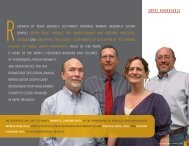
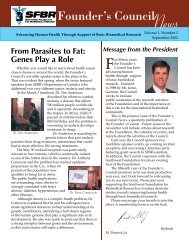
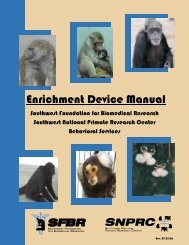
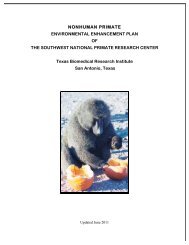
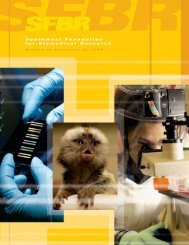
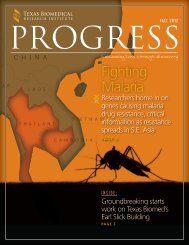
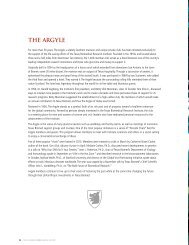
![Vol. 8 No. 2, 2011 [PDF] - Texas Biomedical Research Institute](https://img.yumpu.com/35688099/1/190x245/vol-8-no-2-2011-pdf-texas-biomedical-research-institute.jpg?quality=85)
